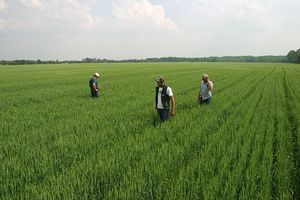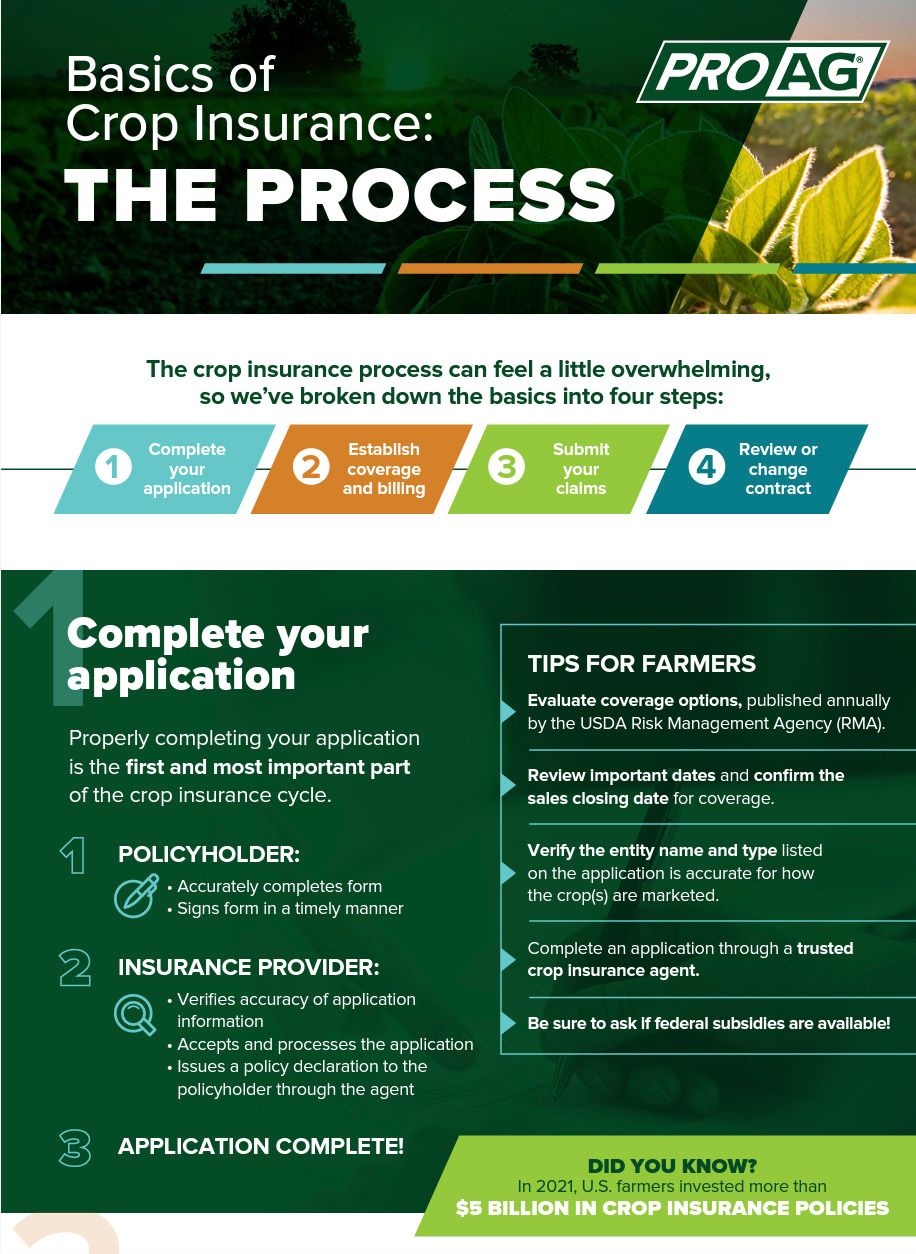Basics of Crop Insurance: The Process in Four Easy Steps
 In 2021, U.S. farmers invested more than $5 billion in crop insurance policies, protecting more than 130 different crops and more than 90% of planted cropland in the U.S.
In 2021, U.S. farmers invested more than $5 billion in crop insurance policies, protecting more than 130 different crops and more than 90% of planted cropland in the U.S.
From historic flooding and drought to derecho damage and other unpredictable events, crop insurance policies have made the difference for farmers adversely impacted by weather or markets. Understanding the importance of crop insurance and how the process works is critical in weathering the storms of agriculture.
We recognize the process can feel a little overwhelming, so let us help break down the basics so you can talk to your agent with confidence.
The crop insurance process can be broken down into four easy-to-understand steps:
- Complete your crop insurance application
- Complete production report, receive coverage summary and billing statement
- Submit claims
- Review or change contract
Let’s dive a bit deeper into each.
1. Complete your crop insurance application.
Whether you’re starting a new policy or renewing your current one, each new year starts with a new insurance offer. The USDA’s Risk Management Agency (RMA) publishes actuarial documents annually, and it’s important to review these documents, your coverage, options and endorsements. Be sure to complete and sign your insurance application no later than the sales closing date specified in the actuarial documents. This date will vary by crop and county. Just like any other insurance, crop insurance is continuous and can be terminated by the policyholder or insurance provider.
Lastly, before submitting your application, be sure to verify the named insured, entity type, identification number(s), crops, coverage and options are valid for how your crop(s) will be marketed for that year. Reference Exhibit 2 (page 209) in the General Standards Handbook for specific person type and documentation requirements. After ensuring accuracy, the application will be submitted via a trusted crop insurance agent.
Summary: Properly completing your application is the first and most important part of the crop insurance cycle. It is vital the form is completed accurately and signed in a timely manner. Upon receipt of the application, the insurance provider will verify the accuracy of the application information, accept and process the application, and issue a summary of coverage to the policyholder and the agent.
2. Complete production report, receive coverage summary and billing statement.
After the application has been completed and accepted by the insurance provider, the next step in the process is production reporting. The policyholder is required to submit a production report detailing the annual production from the previous year for each of their insured crops prior to the production reporting date. The insurance provider uses this information to establish an approved APH yield.
Once the insured crop(s) is planted, the policyholder must submit an acreage reporting form before the acreage reporting date outlined in the actuarial documents. This form includes the following important information for each insured crop:
- Number of acres planted for ALL acres of the crop, including late-planted, prevented planting and uninsurable
- Percent share the farmer has in the acres and applicable shareholder information
- Date the crop was planted
- Practice (irrigated, non-irrigated) / crop type (spring, winter, durum, etc.)
Verify the information reported is accurate before submitting. Underreporting has the potential to leave you with a gap in coverage, while overreporting may result in higher premiums.
Summary: Policyholders are required to submit an acreage report annually. After the report is processed and the provider issues a summary of coverage, a premium bill will be sent to the policyholder based on the acres reported.
3. Submit claims.
Submitting claims – when your crop insurance goes to bat for you.
In the event of crop damage or loss, a written notice of loss of production needs to be filed within 72 hours of initial discovery, but no later than 15 days after the end of the insurance period. Refer to your summary of coverage for any additional requirements in the event of damage or loss. After the damage or loss is determined and verified by an insurance claims representative, the insurance provider will cut an indemnity check, minus any monies owed on the policy, within 30 days.
Summary: It is vital to submit a notice of loss in a timely manner. Of equal importance is knowing the end of the insurance period guidelines and being familiar with your coverage and deductibles.
4. Review or change contract.
When it comes time to renew your policy for the next crop year, RMA may make changes to the policy. These changes will be available on RMA’s website no later than the contract change date and will also be provided in writing no later than 30 days prior to the cancellation date for the insured crop. At this time, the policyholder can review the changes and alert their insurance provider through their trusted agent of continuation or cancellation. The policyholder must submit any change they wish to make no later than the crop’s sales closing date outlined in the actuarial documents. Understanding crop insurance doesn’t have to be overwhelming. With a reliable insurance provider, trusted agent and proper preparation, crop insurance can be exactly what it’s intended to be – a safety net when times get tough. The crop insurance experts at ProAg stand ready to guide you through any questions and respond quickly and accurately to claims.
Summary: RMA often updates policy details and conditions annually, so it’s important to stay in the loop on what has changed. Don’t hesitate to contact your trusted agent with any questions or to discuss any coverage gap areas for the coming year.
Understanding crop insurance doesn’t have to be overwhelming. With a reliable insurance provider, trusted agent and proper preparation, crop insurance can be exactly what it’s intended to be – a safety net when times get tough. The crop insurance experts at ProAg stand ready to guide you through any questions and respond quickly and accurately to claims.

